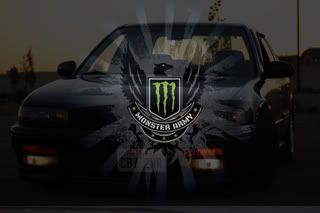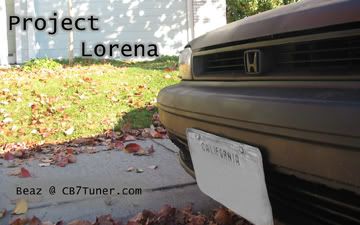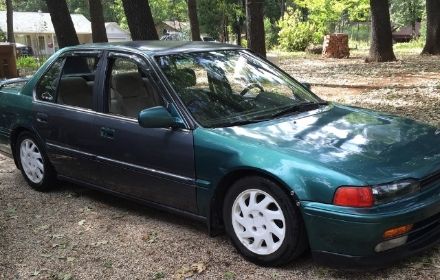I have been trying to compile all the knowledge that may beginners are seeking, and to have all that information in one "stickied" thread. To accomplish this I have been working on gathering as much information both from this site and searching the internet for anything that isnt mentioned on this site. So here it goes. Hopefully this will help.
More Power:
One of the first questions people ask when they get involved in a "tuner" car performance is "What can I do to my car to make it faster/better looking?" or, if they have done any research already, "What should I do first?" These questions are asked over and over by new members of this site and then half answered by veteran members who have gotten tired of repeatedly answering these same questions. This therad's purpose is intended to give the whole answer to these commonly asked questions.
Three Cornerstones of "tuner" Performance:
The first thing people often want to do is increase the power of their car. The first steps in this process have been simplified down to three key elements: Intake, Header and Exhaust (often written as i/h/e on the bulletin board). These three areas are usually the first to be addressed when seeking improvements in performance. Japanese performance engines (and Honda/Acura engines in particular) are fairly well optimized for performance and making any changes to the internal engine components are relatively expensive and complex for a beginner to undertake themselves. The air intake and exhaust systems, conversely, are designed mainly to be functional, quiet and inexpensive to manufacture. Since these pedestrian concerns are low on the list of priorities for most of us that are looking for more power, there are significant gains that can be made in these areas without spending large sums of money.
Fresh Air:
The air intake system is made up of three key components: air filter, air box and related tubes. An air filter is used to remove harmful dirt particles from entering the engine and causing wear. The filter is made of a fire resistant material to prevent a fire in the intake manifold from getting out into the engine bay. The filter usually resides in an air box or canister. This shields the filter from the under hood heat, dirt and water. Air enters the system from outside the car near the fender or behind one of the head lights and enters the (usually) plastic pipe system. The air is taken from a location that is intended to exclude the hot air from under the hood. The air moves along the pipes into the air box where it is forced to pass through the air filter and then back out into more pipes that take the filtered air to the inlet side of the throttle body.
The routing and shape of the pipes used to carry the air from the outside to the throttle body are often awkward and designed more to suppress sound. At higher rpms this intake can be restrictive and limit top end power. To help this, the air filter can be replaced by a high flow replacement filter like a K&N reusable filter or the entire intake system is replaced. A replacement intake usually is comprised of a smooth, large diameter pipe that takes a direct path from the throttle body to a location under the hood or in one of the fenders, where there is a source of cool air. At the end of the pipe a large high volume air filter is used to keep the incoming air clean.
Key to getting more power from any engine is getting more air into and out of the engine. By allowing more air into the engine this modification can be responsible for a power increase on average of 0 to 5 horsepower and increases the amount of sound coming from under the hood.
Exhaust Manifolds/Headers:
The stock exhaust manifolds on most cars are designed to be simple and inexpensive. Cast from iron they are intended only to bring the exhaust gases from each cylinder together into one path so it can enter the exhaust system. While they do this job quietly and inexpensively, cast iron manifolds can be far from efficient performance wise.
Exhaust manifolds (or headers) increase the performance of an engine by providing a smooth restriction free path for the exhaust gasses to follow. By getting more exhaust out of the engine, more air/fuel can be drawn in from the intake. Since exhaust air does not aid combustion and will not expand any further to push the piston down, any space in the cylinder taken up by exhaust gasses is wasted space (effectively reducing the engine displacement).
Exhaust gasses exit an engine in pulses of pressure. This principal can be used by a properly designed header to scavenge the exhaust from the cylinders even more than if each exhaust tube simply exited to the atmosphere. These pressure waves that travel down the tube have a high pressure front and is followed by a low pressure area behind it. This low pressure area can be used to draw exhaust out of another cylinder by arranging for this low pressure area to arrive at the end of a tube for another cylinder that is just opening the exhaust port. In four cylinder engines the tri-y design (where no more than two tubes join at a measured distance from the engine) is used to take advantage of this principal. Headers designed for higher rpm performance may use a more simpler four into one design with longer pipe lengths. Pipe diameter also has a big impact on the performance characteristics of the header.
A tubular exhaust header can have a significant impact on power (7 to 13 horsepower), but comes at the expense of increased noise. Tubular exhaust headers are also often responsible for improved fuel economy. However, they are more difficult to install and far more costly than an intake system.
Exhaust:
The exhaust system is often the first thing that car enthusiasts like to change on their car and has the biggest impact on the look and sound of the car. Intakes and headers are hidden away under the hood, but the shiny stainless muffler and big exhaust tip are seen by everyone. This is often where there is the most to choose from. There are literally hundreds of exhaust tips to choose from and many mufflers. The nature of the exhaust system is also such that many different mufflers can be used on many different cars.
When changing your exhaust system there is two routes you can take. There are companies that market complete cat-back (from the catalytic converter to the tail pipe) systems. These systems are usually legal for use in states with strict pollution and sound laws and they can often be installed without any special tools. You can also choose to go the custom route by choosing a muffler and tip and having it custom installed by a muffler shop who can mandrel bend tubing to suite your car. This method is often less expensive than an off the shelf system and provides much more choice and flexibility. Custom systems are often louder than commercial systems. Complete systems are designed to meet stringent sound standards and are often quieter than systems built from universal components.
In either case it is best to select components made from stainless steel. While not as important in Southern states, in the Northern states and Canada winter and road salt can rapidly deteriorate your exhaust system. When paying a premium for high performance and/or custom components you want them to last as long as possible. It is not often done, but many shops that custom fabricate exhaust systems will create a full stainless system. The cost of stainless pipe is more than standard mild steel, but not so high that it is not worth paying the premium. If one shop refuses to use stainless steel pipe then you might consider thanking him/her for their time and moving on to the next shop.
Much has been said about the correct pipe diameter and the need for back pressure to keep from losing torque in small import engines. While the debate has never been conclusively resolved from a scientific standpoint, experience has proven that oversized pipes on small engines do cause a loss of torque. On small (1.6 Litre to 2.4 Litre) four cylinder engines most agree that 2.25 inch pipe is the best size to use. In engines with forced induction (turbos, superchargers) then 2.5 inch pipe is good.
Customizing the exhaust of your car will certainly result in a louder exhaust note (which is often the primary goal for the customization) and by making the exhaust more efficient can result in a 5 to 7 horsepower increase on average. Replacing the catalytic converter with a high flow design can also increase this number up to 10 horsepower. Much like the header, a high efficincy exhaust system can also be responsible for a minor increase in fuel economy.
Additional Bolt-ons:
While the Intake/Header/Exhaust combination are certainly the most popular modifications there are other bolt-on modifications that create more power. High power and/or multiple spark ignition systems, while not creating a great deal of power on their own, can be responsible for a noticable power increase in slightly modified engines. Adjustable camshaft sprockets are also a popular upgrade for people looking to optimize the torque and horspower curve for their engine. The camshaft timing is set by the factory to provide a smooth and fuel efficient compromise for the engine. By adjusting the timing of the camshafts both in relationship to the crank shaft and relative to each other (in DOHC engines) large gains can be made at certain parts of the rev range (i.e. more top end horsepower at the expense of a little low end torque). There are many other bolt-on methods that may produce power increases but none of them should be attempted unless the intitial intake/header/exhaust modifications have been considered.
KEEP READING.. Continued Below...
More Power:
One of the first questions people ask when they get involved in a "tuner" car performance is "What can I do to my car to make it faster/better looking?" or, if they have done any research already, "What should I do first?" These questions are asked over and over by new members of this site and then half answered by veteran members who have gotten tired of repeatedly answering these same questions. This therad's purpose is intended to give the whole answer to these commonly asked questions.
Three Cornerstones of "tuner" Performance:
The first thing people often want to do is increase the power of their car. The first steps in this process have been simplified down to three key elements: Intake, Header and Exhaust (often written as i/h/e on the bulletin board). These three areas are usually the first to be addressed when seeking improvements in performance. Japanese performance engines (and Honda/Acura engines in particular) are fairly well optimized for performance and making any changes to the internal engine components are relatively expensive and complex for a beginner to undertake themselves. The air intake and exhaust systems, conversely, are designed mainly to be functional, quiet and inexpensive to manufacture. Since these pedestrian concerns are low on the list of priorities for most of us that are looking for more power, there are significant gains that can be made in these areas without spending large sums of money.
Fresh Air:
The air intake system is made up of three key components: air filter, air box and related tubes. An air filter is used to remove harmful dirt particles from entering the engine and causing wear. The filter is made of a fire resistant material to prevent a fire in the intake manifold from getting out into the engine bay. The filter usually resides in an air box or canister. This shields the filter from the under hood heat, dirt and water. Air enters the system from outside the car near the fender or behind one of the head lights and enters the (usually) plastic pipe system. The air is taken from a location that is intended to exclude the hot air from under the hood. The air moves along the pipes into the air box where it is forced to pass through the air filter and then back out into more pipes that take the filtered air to the inlet side of the throttle body.
The routing and shape of the pipes used to carry the air from the outside to the throttle body are often awkward and designed more to suppress sound. At higher rpms this intake can be restrictive and limit top end power. To help this, the air filter can be replaced by a high flow replacement filter like a K&N reusable filter or the entire intake system is replaced. A replacement intake usually is comprised of a smooth, large diameter pipe that takes a direct path from the throttle body to a location under the hood or in one of the fenders, where there is a source of cool air. At the end of the pipe a large high volume air filter is used to keep the incoming air clean.
Key to getting more power from any engine is getting more air into and out of the engine. By allowing more air into the engine this modification can be responsible for a power increase on average of 0 to 5 horsepower and increases the amount of sound coming from under the hood.
Exhaust Manifolds/Headers:
The stock exhaust manifolds on most cars are designed to be simple and inexpensive. Cast from iron they are intended only to bring the exhaust gases from each cylinder together into one path so it can enter the exhaust system. While they do this job quietly and inexpensively, cast iron manifolds can be far from efficient performance wise.
Exhaust manifolds (or headers) increase the performance of an engine by providing a smooth restriction free path for the exhaust gasses to follow. By getting more exhaust out of the engine, more air/fuel can be drawn in from the intake. Since exhaust air does not aid combustion and will not expand any further to push the piston down, any space in the cylinder taken up by exhaust gasses is wasted space (effectively reducing the engine displacement).
Exhaust gasses exit an engine in pulses of pressure. This principal can be used by a properly designed header to scavenge the exhaust from the cylinders even more than if each exhaust tube simply exited to the atmosphere. These pressure waves that travel down the tube have a high pressure front and is followed by a low pressure area behind it. This low pressure area can be used to draw exhaust out of another cylinder by arranging for this low pressure area to arrive at the end of a tube for another cylinder that is just opening the exhaust port. In four cylinder engines the tri-y design (where no more than two tubes join at a measured distance from the engine) is used to take advantage of this principal. Headers designed for higher rpm performance may use a more simpler four into one design with longer pipe lengths. Pipe diameter also has a big impact on the performance characteristics of the header.
A tubular exhaust header can have a significant impact on power (7 to 13 horsepower), but comes at the expense of increased noise. Tubular exhaust headers are also often responsible for improved fuel economy. However, they are more difficult to install and far more costly than an intake system.
Exhaust:
The exhaust system is often the first thing that car enthusiasts like to change on their car and has the biggest impact on the look and sound of the car. Intakes and headers are hidden away under the hood, but the shiny stainless muffler and big exhaust tip are seen by everyone. This is often where there is the most to choose from. There are literally hundreds of exhaust tips to choose from and many mufflers. The nature of the exhaust system is also such that many different mufflers can be used on many different cars.
When changing your exhaust system there is two routes you can take. There are companies that market complete cat-back (from the catalytic converter to the tail pipe) systems. These systems are usually legal for use in states with strict pollution and sound laws and they can often be installed without any special tools. You can also choose to go the custom route by choosing a muffler and tip and having it custom installed by a muffler shop who can mandrel bend tubing to suite your car. This method is often less expensive than an off the shelf system and provides much more choice and flexibility. Custom systems are often louder than commercial systems. Complete systems are designed to meet stringent sound standards and are often quieter than systems built from universal components.
In either case it is best to select components made from stainless steel. While not as important in Southern states, in the Northern states and Canada winter and road salt can rapidly deteriorate your exhaust system. When paying a premium for high performance and/or custom components you want them to last as long as possible. It is not often done, but many shops that custom fabricate exhaust systems will create a full stainless system. The cost of stainless pipe is more than standard mild steel, but not so high that it is not worth paying the premium. If one shop refuses to use stainless steel pipe then you might consider thanking him/her for their time and moving on to the next shop.
Much has been said about the correct pipe diameter and the need for back pressure to keep from losing torque in small import engines. While the debate has never been conclusively resolved from a scientific standpoint, experience has proven that oversized pipes on small engines do cause a loss of torque. On small (1.6 Litre to 2.4 Litre) four cylinder engines most agree that 2.25 inch pipe is the best size to use. In engines with forced induction (turbos, superchargers) then 2.5 inch pipe is good.
Customizing the exhaust of your car will certainly result in a louder exhaust note (which is often the primary goal for the customization) and by making the exhaust more efficient can result in a 5 to 7 horsepower increase on average. Replacing the catalytic converter with a high flow design can also increase this number up to 10 horsepower. Much like the header, a high efficincy exhaust system can also be responsible for a minor increase in fuel economy.
Additional Bolt-ons:
While the Intake/Header/Exhaust combination are certainly the most popular modifications there are other bolt-on modifications that create more power. High power and/or multiple spark ignition systems, while not creating a great deal of power on their own, can be responsible for a noticable power increase in slightly modified engines. Adjustable camshaft sprockets are also a popular upgrade for people looking to optimize the torque and horspower curve for their engine. The camshaft timing is set by the factory to provide a smooth and fuel efficient compromise for the engine. By adjusting the timing of the camshafts both in relationship to the crank shaft and relative to each other (in DOHC engines) large gains can be made at certain parts of the rev range (i.e. more top end horsepower at the expense of a little low end torque). There are many other bolt-on methods that may produce power increases but none of them should be attempted unless the intitial intake/header/exhaust modifications have been considered.
KEEP READING.. Continued Below...










Comment